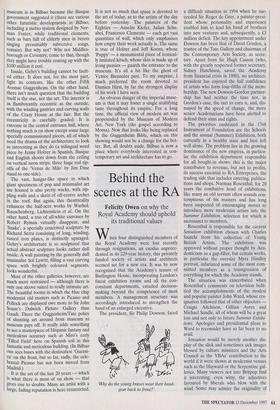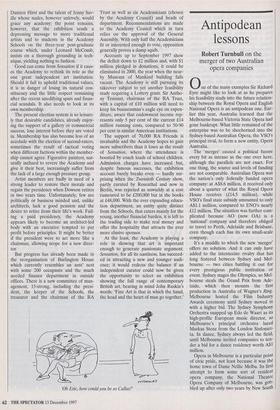Behind the scenes at the RA
Felicity Owen on why the Royal Academy should uphold its traditional values When four distinguished members of the Royal Academy were lost recently through resignations, an exodus unprece- dented in its 229-year history, this privately funded society of artists and architects seemed set for a new era. It was by now recognised that the Academy's tenure of Burlington House, incorporating London's finest exhibition rooms and all the con- comitant departments, entailed decision- making beyond the competence of most members. A management structure was accordingly introduced to strengthen the hand of an enlarged executive.
The president, Sir Philip Dowson, faced 'Why do the young braves wear their head- gear back to front?' a difficult situation in 1994 when he suc- ceeded Sir Roger de Grey, a painter-presi- dent whose personality and experience enabled him to lead his band of brothers into new ventures and, subsequently, a £.3 million deficit. The key appointment under Dowson has been that of David Gordon, a trustee of the Tate Gallery and chairman of the Contemporary Arts Society, as secre- tary. Apart from Sir Hugh Casson (who, with the greatly respected former secretary, Sidney Hutchison, saved the Academy from financial crisis in 1980), no architect- president has enjoyed the full confidence of artists who form four-fifths of the mem- bership. The new Dowson-Gordon partner- ship has had neither the time nor, in Gordon's case, the tact to earn it, and, dis- mayed by the speed of change, the more senior Academicians have been alerted to defend their aims and rights.
The priorities enshrined in the 1768 Instrument of Foundation are the Schools and the annual (Summer) Exhibition, both currently in a healthy state and best left well alone. The problem lies in the growing dominance of the new empires, in particu- lar the exhibition department responsible for all bought-in shows: this is the major contributor to revenue, but not to profits, its success essential to RA Enterprises, the trading side that includes catering, publica- tions and shops. Norman Rosenthal, for 20 years the combative head of exhibitions, like many an old servant often sounds con- temptuous of his masters and has long been suspected of encouraging moves to introduce more modernist artists into the Summer Exhibition, selection for which is sacrosanct to members.
Rosenthal is responsible for the current Sensation exhibition chosen with Charles Saatchi from his collection of Young British Artists. The exhibition was approved without proper thought by Aca- demicians as a gap-filler, but certain works, in particular the oversize Myra Hindley portrait, infuriated some of the most com- mitted members as a transgression of everything for which the Academy stands.
The situation was exacerbated when Rosenthal's comments on television belit- tled the accomplishments of the modest and popular painter John Ward, whose res- ignation followed that of other objectors — Craigie Aitchison, Gillian Ayres and Michael Sandle, all of whom will be a great loss and not only to future Summer Exhibi- tions. Apologies and presidential pleas to Ward to reconsider have so far been to no avail.
Sensation would be merely another dis- play of the slick and sometimes sick images blessed by culture ministers and the Arts Council as the YBAs' contribution to the world if it were shown at modernist venues such as the Hayward or the Serpentine gal- leries. Many viewers not into Britpop find it interesting, even witty, the adjectives favoured by liberals who blow with the wind. Some may admire the originality of Damien Hirst and the talent of Jenny Sav- ille whose nudes, however unlovely, would grace any academy; the point remains, however, that the exhibition sends a depressing message to more traditional artists and to students in the Academy Schools on the three-year post-graduate course which, under Leonard McComb, insists on a thorough grounding in tech- nique, yielding nothing to fashion.
Good can come from Sensation if it caus- es the Academy to rethink its role as the one great independent art institution. Should it fail to uphold traditional values, it is in danger of losing its natural con- stituency and the little respect remaining after the recent unedifying spats and finan- cial scandals. It also needs to look at its own membership.
The present election system is so leisure- ly that desirable candidates, already enjoy- ing the support of a gallery or commercial success, lose interest before they are voted in. Membership has also become less of an accolade with the election of second-raters, sometimes the result of tactical voting when different factions within the member- ship cannot agree. Figurative painters, nat- urally inclined to revere the Academy and give it their best, increasingly suffer from the lack of a large enough pressure group.
Artist members are badly in need of a strong leader to restore their morale and regain the presidency when Dowson retires in two years time. Unfortunately, few are politically or business minded and, unlike architects, lack a good pension and the desire to retire from their life's work. Fail- ing a paid presidency, the Academy appears likely to become an architect-led body with an executive tempted to put profit before principles. It might be better if the president were to act more like a chairman, allowing scope for a new direc- tor.
But progress has already been made in the reorganisation of Burlington House which currently resembles an ants' nest with some 200 occupants and the much needed finance department in outside offices. There is a new committee of man- agement, 15-strong, including the presi- dent, the keeper of the Schools, the treasurer and the chairman of the RA Trust as well as six Academicians (chosen by the Academy Council) and heads of department. Recommendations are made to the Academy Council which in turn relies on the approval of the General Assembly. With only half the Academicians fit or interested enough to vote, opposition generally proves a damp squib.
Accounts up to September 1997 show the deficit down to £2 million and, with $1 million pledged in donations, it could be eliminated in 2000, the year when the near- by Museum of Mankind building falls vacant. The Academy is still pursuing its takeover subject to yet another feasibility study requiring a Lottery grant. Sir Antho- ny Tennant, chairman of the RA Trust, with a capital of £10 million will need to keep his businessman's eagle eye on expen- diture, aware that endowment income rep- resents only 5 per cent of the current £14 million running costs, compared to 50-90 per cent in similar American institutions.
The support of 70,000 RA Friends is invaluable and the Academy hopes to gain more subscribers than it loses as the result of Sensation, where the attendance is boosted by coach loads of school children. Admission charges have increased but, despite famous successes, the exhibition account barely breaks even — hardly sur- prising when the Twentieth Century show, partly curated by Rosenthal and now in Berlin, was rejected as unwieldy at a cost rumoured to be £200,000 but in the books at £48,000. With the ever expanding educa- tion department, an entity quite distinct from the Schools, that caters mainly for the young, another financial burden, it is left to the trading side to make real money and offer the hospitality that attracts the ever more elusive sponsor.
At the least, the Academy is playing a role in showing that art is important enough to generate passionate argument. Sensation, for all its nastiness, has succeed- ed in attracting a new and younger audi- ence; it would redress the balance if an independent curator could now be given the opportunity to select an exhibition showing the full range of contemporary British art, bearing in mind John Ruskin's words: 'Fine Art is that in which the hand, the head and the heart of man go together.'
'Oh Eric, how could you be so Callas?'



















































































 Previous page
Previous page